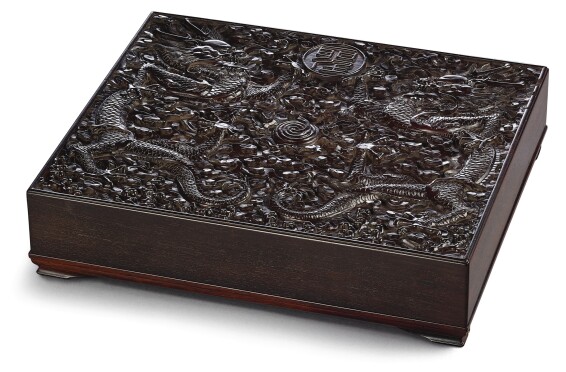- 3512
A FINELY CARVED ZITAN 'DRAGON' DOCUMENT BOX AND COVERQING DYNASTY, QIANLONG PERIOD |
Estimate
800,000 - 1,000,000 HKD
Log in to view results
bidding is closed
Description
- 34.9 by 28.9 by 8.4 cm, 13 3/4 by 11 3/8 by 3 1/4 in.
of rectangular form, the box constructed with a low flange and supported on four short splayed bracket feet, the cover with straight sides and a top well carved with a pair of five-clawed dragons soaring sinuously against dense ruyi cloud scrolls and flanking a central flaming pearl below a medallion enclosing the sheng character, each mythical beast rendered ferocious and superbly detailed with a scaly body, all framed within a raised border, the dark reddish-brown wood with a rich patina
Catalogue Note
During the Qianlong Emperor’s reign, great attention was paid not only to the manufacture of artefacts but also to the packaging and protection of the Emperor's treasures and paraphernalia. According to the Qing archives, the Emperor himself often inspected the packaging and it was not uncommon for the Emperor to modify the plans submitted to him before approving the Palace Workshop (Zaobanchu), which operated under the command of the Imperial Household Department (Neiwufu), to proceed with the production, which was sometimes sent to be executed in South China. Under such rigorous standards and expectations, objects made under the auspices of the Palace Workshop highly reflect the Emperor’s artistic taste and demand – as well as the supremacy of imperial authority. Superbly carved with a pair of dragons soaring sinuously and flanking a sheng medallion, the current zitan box and cover, which may have been used to store writing paper or imperial documents, encapsulate the imperial splendour of the Qianlong reign and the Emperor's utmost attention to detail. In addition to the employment of the five-clawed dragon motif, the ultimate symbol of the Emperor’s mandate and supremacy, the choice of zitan, which was the Qianlong Emperor’s favoured wood type – and of which use was closely monitored to avoid any waste – is also a testament to the importance of the present box and cover.
The design on the cover is extremely rare and no identical example appears to be recorded but there are notable similarities in the workmanship and design with a zitan box and cover in the Palace Museum, Beijing, illustrated in the exhibition catalogue Qing Legacies: The Sumptuous Art of Imperial Packaging, The Macau Museum of Art, Macau, 2000, cat. no. 29. The box and cover in the Palace Museum, which houses six ink cake boxes and covers, is similarly carved on the cover with a pair of dragons sinuously soaring against ruyi clouds but is centred with a cartouche enclosing an inscription reading Xing chi shi gu (Archaistic Star Pond) and further decorated with jagged rockwork and crashing waves.
The design on the cover is extremely rare and no identical example appears to be recorded but there are notable similarities in the workmanship and design with a zitan box and cover in the Palace Museum, Beijing, illustrated in the exhibition catalogue Qing Legacies: The Sumptuous Art of Imperial Packaging, The Macau Museum of Art, Macau, 2000, cat. no. 29. The box and cover in the Palace Museum, which houses six ink cake boxes and covers, is similarly carved on the cover with a pair of dragons sinuously soaring against ruyi clouds but is centred with a cartouche enclosing an inscription reading Xing chi shi gu (Archaistic Star Pond) and further decorated with jagged rockwork and crashing waves.

